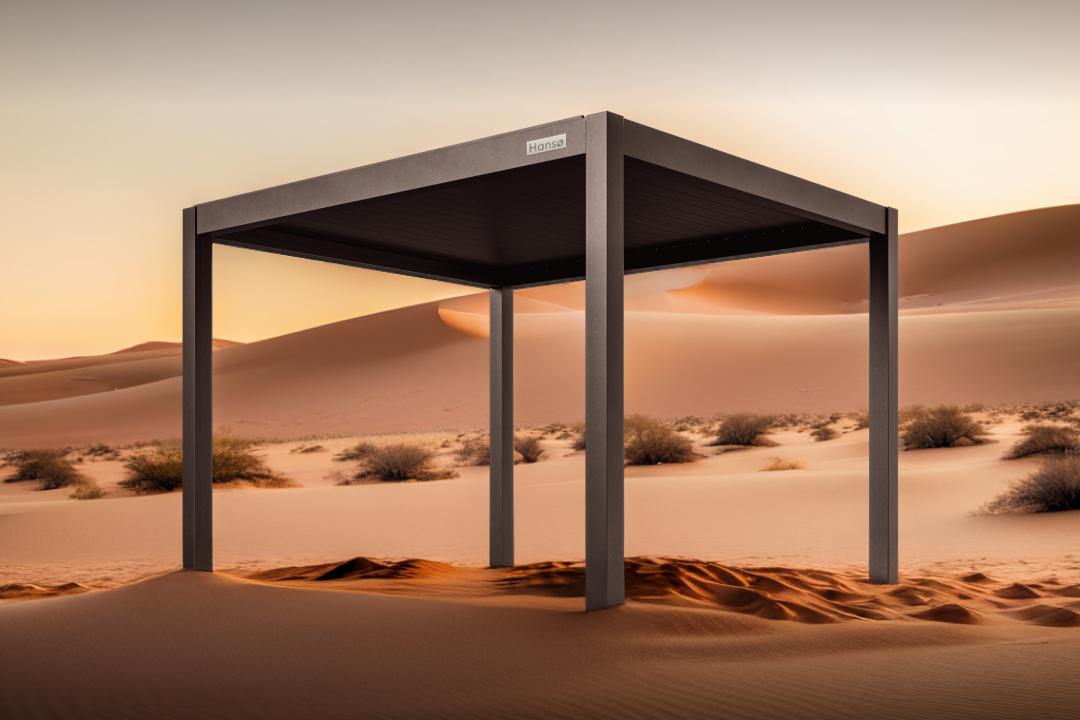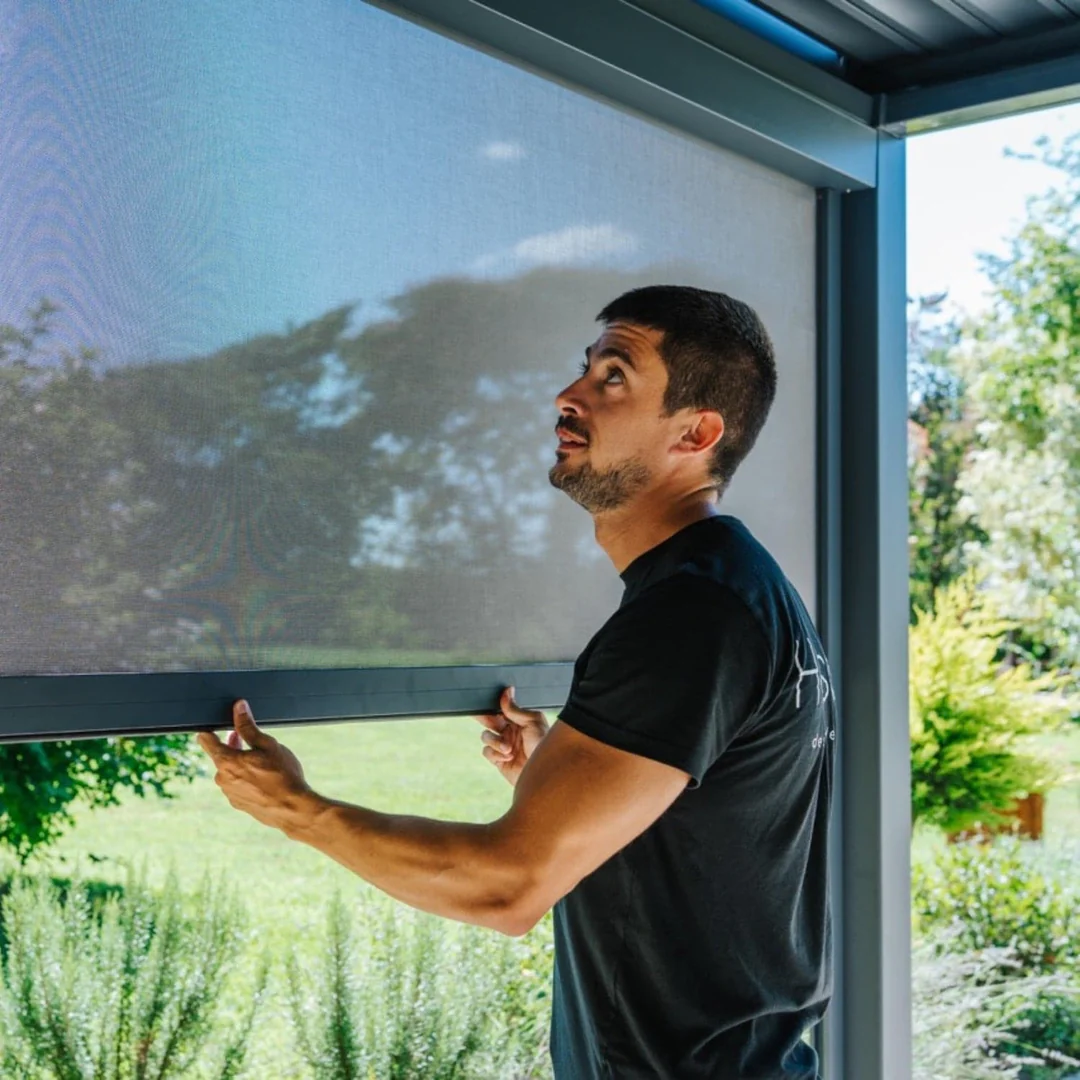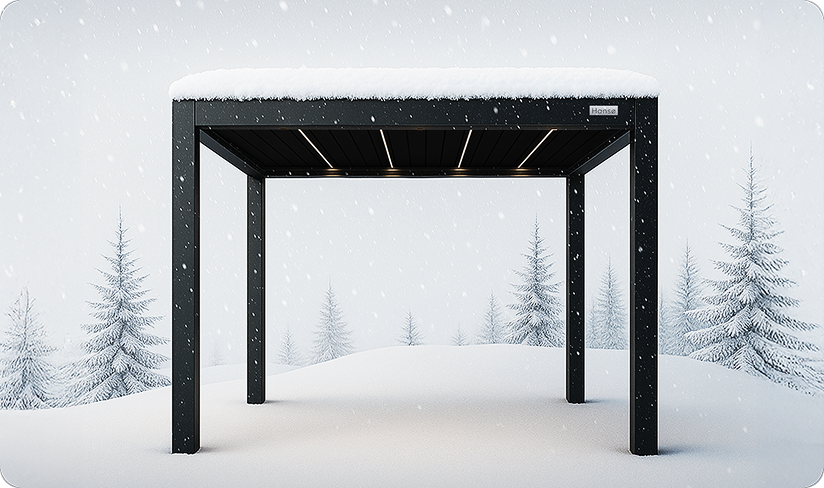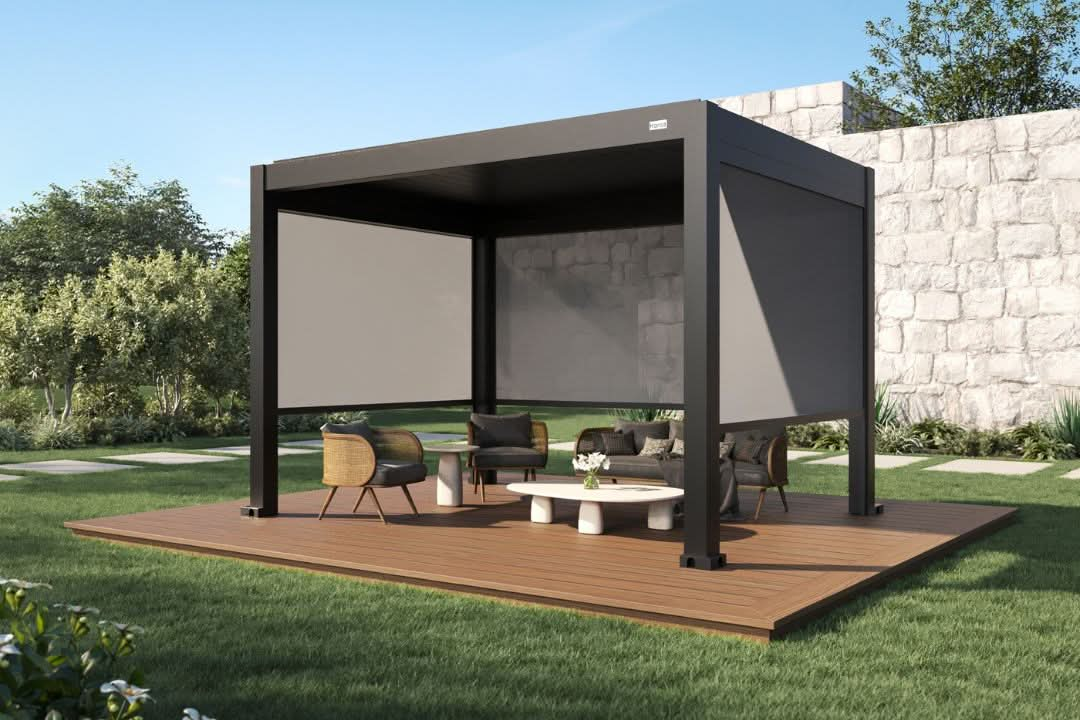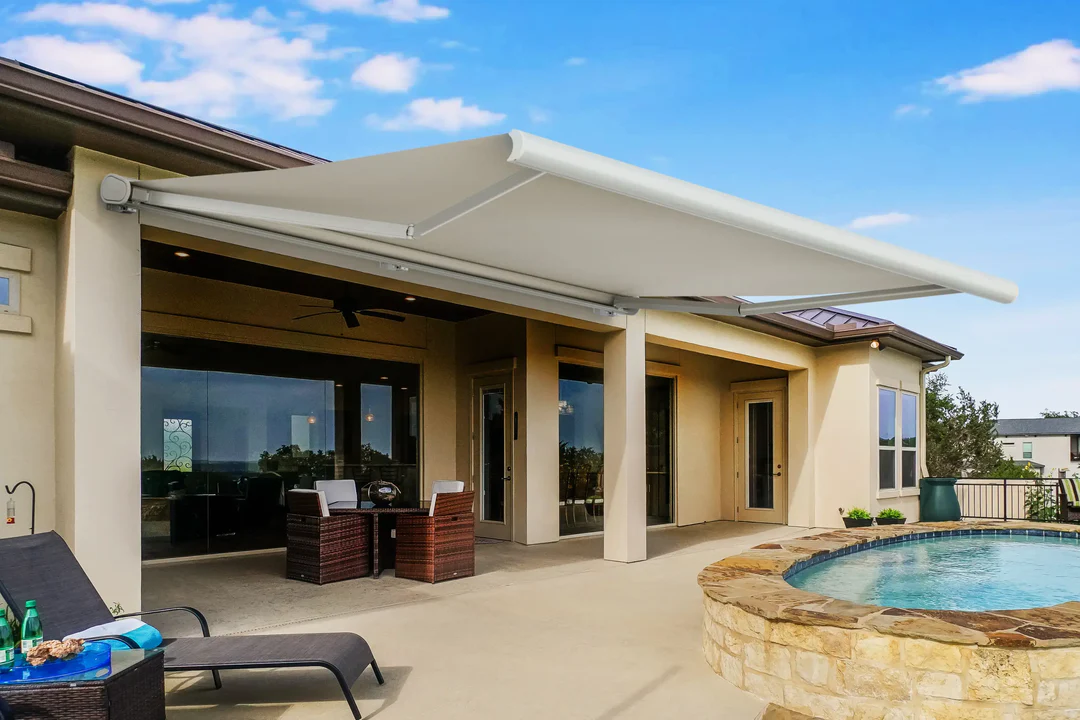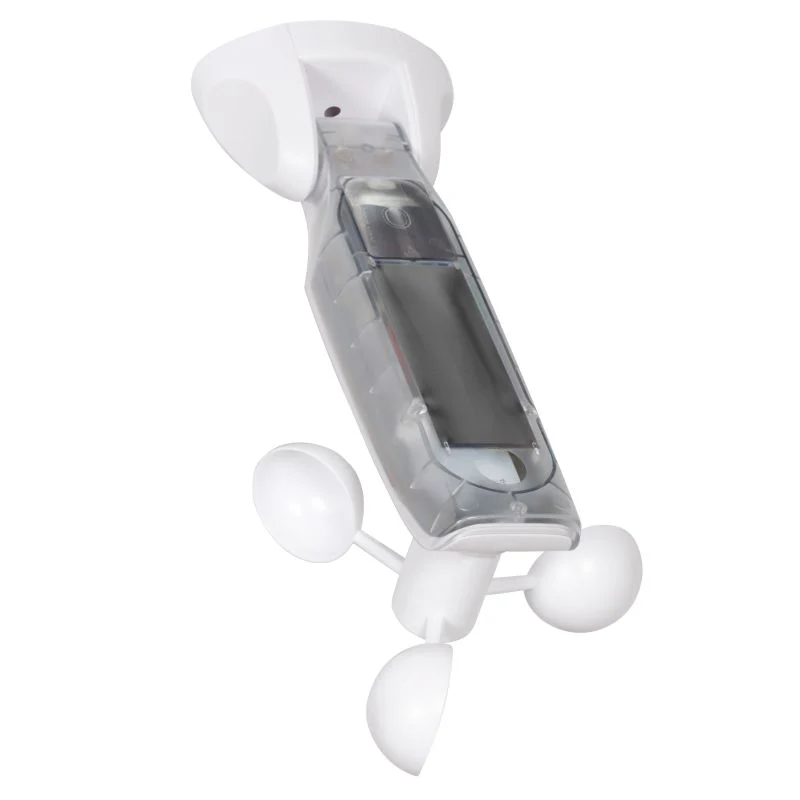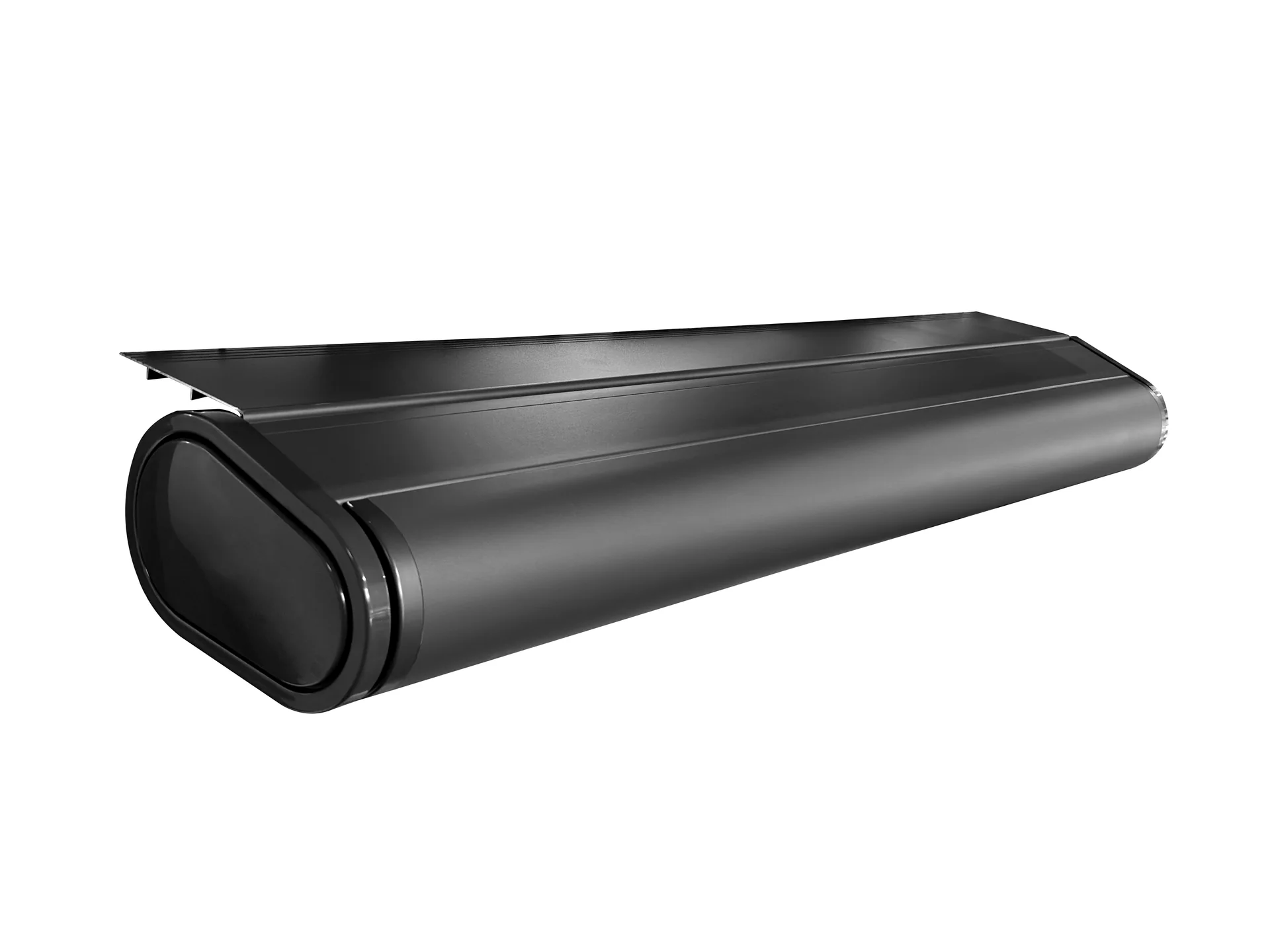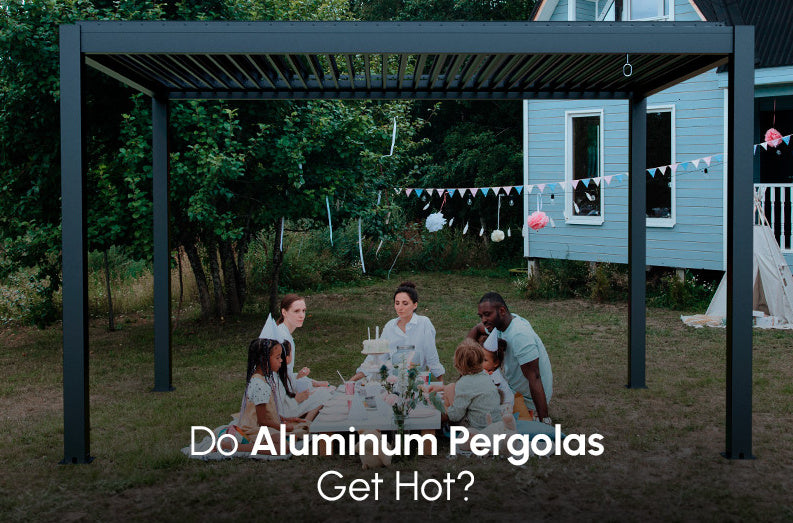8 Pergola Flooring Ideas & Options: Ultimate List

While many focus solely on the pergola's design, it's essential to consider the floor beneath it.
Pergola flooring ideas & options can dramatically impact the aesthetics and functionality of your structure.
Let's explore!
What is Pergola Flooring?

Pergola flooring refers to the ground surface or foundation underneath a pergola, often made of materials like wood, tiles, concrete, or gravel. It provides stability and enhances the overall aesthetics of the pergola space.
From concrete slabs and natural wood to ceramic tiles and slate pavers, pergola flooring ideas have exploded in popularity.
Here's the thing:
Pergola flooring isn't just about the base. It’s about complementing your structure - be it wooden or the superior aluminum pergola.
When you think about an afternoon with family on a wooden deck or a night with friends around a fire pit on a stamped concrete patio, the flooring plays a pivotal role.
8 Best Pergola Flooring Ideas For A Cohesive Look
1. Tinted Concrete with Geometric Patterns
If you've been on the hunt for the best pergola flooring ideas, the allure of tinted concrete with geometric patterns may have already caught your attention.
But what makes it such a buzzworthy option for your outdoor space?
Concrete, as a flooring material, has always been a go-to for its durability and ease of maintenance.
But when you infuse it with vibrant hues and etch it with intricate geometric patterns, it transforms from being a mere flooring option to a canvas of art for your outdoor patios.
Whether you fancy bold triangles, intricate hexagons, or a mosaic of different shapes, the design possibilities are endless. And, with professional help, achieving a sleek finish is a breeze.
One might think that such an exquisite flooring option would be cumbersome to install, but that's far from the truth. The process is almost akin to traditional concrete flooring but with an unexpected flair.
Now:
Once the concrete mix is poured and leveled, tints are added to achieve the desired hue. While the concrete is still wet, stencils or stamps are used to imprint the chosen geometric designs.
The beauty of this process is the room it offers for creativity. Whether you fancy bold triangles, intricate hexagons, or a mosaic of different shapes, the design possibilities are endless. And, with professional help, achieving a sleek finish is a breeze.
2. Interlocking Deck Tiles
Talking about outdoor flooring options interlocking deck tiles emerge as a frontrunner for those seeking a blend of beauty and simplicity.
Known for their modularity and ease of installation, these tiles can completely redefine the aesthetic of your outdoor living space.
But when considering this option, which variant should you opt for concrete or hardwood?
Concrete, as mentioned, as a flooring material has long been associated with durability and modern aesthetics. When molded into interlocking deck tiles, it offers a contemporary touch to your pergola's foundation. The subtle shades of gray and the sleek finish of concrete tiles can perfectly complement the modern lines of, for example, an aluminum pergola.
The beauty of these tiles lies in their versatility. They can be arranged in various patterns, allowing homeowners to customize their outdoor patio design uniquely.
Transitioning to hardwood, ipe interlocking deck tiles introduce a warm and organic feel to your outdoor space. The rich tones of ipe, ranging from reddish-brown to amber, can infuse a natural charm beneath your pergola.
Its fine grain and smooth finish add a layer of sophistication, making it a stellar companion to both wooden and aluminum pergolas.
Beyond aesthetics, Ipe is renowned for its incredible durability and it rivals even the most resilient outdoor flooring materials.
What about installation?
They are designed to fit together like puzzle pieces, these tiles can be laid on any flat surface, making them an ideal choice for covering unsightly concrete or uneven surfaces.
No need for nails, glue, or complex tools. Simply snap them together, and within hours, witness the transformation of your patio floor.
3. Terrazzo Flooring
With so many stone flooring options for pergolas, it's clear that terrazzo flooring is one of the most classic options.
An enchanting concoction of chipped marble, quartz, granite, or even glass set in concrete, terrazzo offers an unparalleled aesthetic flair. It's a statement floor and one that's perfectly poised to elevate the luxury of your outdoor living space.
Terrazzo flooring is a visual spectacle. Its intricate patterns and kaleidoscope of colors can instantly infuse vibrancy into your outdoor patio.
Its versatile nature means that terrazzo can be tailored to suit any personal taste. Whether you lean towards subtle earthy tones or bold, contrasting patterns, terrazzo offers an endless palette to play with, ensuring your pergola becomes an embodiment of your style.
At first glance, terrazzo might seem like a complex flooring option to install, given its intricate design.
But in reality, modern installation techniques have simplified the process. Once your chosen mix of aggregates is set in a concrete or epoxy base, it's poured onto the patio floor.
After it has set, the surface is polished to reveal the beauty of the aggregates embedded within, giving it that iconic, glossy finish.
One of the perks of opting for terrazzo is its continuity. Unlike tiles, which can break the flow of design with grout lines, terrazzo offers an uninterrupted visual experience, making your outdoor space look more expansive and cohesive.
4. Cork Flooring
As we go deeper into the maze of patio flooring options, cork flooring stands out as an eco-friendly gem.
This material is derived from the bark of the cork oak tree, so combining the inherent properties of nature with state-of-the-art flooring technology.
Enveloping your outdoor living space in its warm and tactile embrace, cork provides a distinctive touch that harmoniously complements both the natural and modern aesthetics of a pergola.
Cork flooring exudes an earthy charm, marked by its characteristic honeycomb structure.
Its natural, uneven texture and rich, earth-toned hues can lend your patio a rustic look while still resonating with the sophisticated design of a modern aluminum pergola.
But it's not just about the looks.
Cork floors carry with them a myriad of benefits that amplify their appeal. Chief among them is their resistance to rot and mold.
Think about it: an outdoor patio that's exposed to the elements requires a floor that can stand its ground.
Cork, with its cellular structure, naturally repels water, giving your floors a waterproof functionality. So, come rain or high humidity, your cork floor remains unscathed.
Another feather in the cork's cap is its natural insulating properties. It not only offers a cushiony surface but also helps moderate the temperature, making your outdoor space cooler in summer but also helps to winterize it.
Furthermore, the installation of cork flooring, much like deck tile flooring, has been streamlined over the years.
Available in tiles or planks, they can be laid over existing flooring or directly on the concrete slab.
Often equipped with interlocking edges, these cork pieces snap together, eliminating the need for adhesives or nails. And once in place, a sealant is applied to boost its weather-resistant properties further.
5. Natural Slate Flooring
As we look further into the range of pergolas flooring options, the natural beauty of slate captures our attention.
Having a rough surface and real patterns, natural slate flooring is a beautiful example of making any outdoor area feel wild and elegant.
Unlike its polished counterparts, natural slate flooring revels in its imperfections.
The uneven patterns, varied shades ranging from deep charcoal to rust and mossy greens, and the tactile texture of slate bring a raw, elemental charm to your outdoor patio.
Slate works as a bridge between the modern and the ancient, the tamed and the wild. It looks great next to the clean lines of a modern aluminum pergola or the natural look of a wooden structure.
The benefits of slate don't just stop at aesthetics. Known for its durability and strength, slate can resist the harshest of conditions.
Those unpredictable rain showers or high traffic areas, Slate stands resilient, its colors unfading and it's surface unyielding.
6. Gravel Flooring
As we navigate through the diverse pergola flooring ideas, there's an undeniable allure in the humblest of materials: gravel.
Gravel flooring offers a raw, rustic appeal, weaving a tapestry of simplicity and authenticity.
When situated under a sleek aluminum pergola or even a louvered structure, the contrast of the coarse gravel with the refined pergola above creates a balanced harmony in your outdoor space.
There's something undeniably nostalgic about the crunch of gravel underfoot.
This material, with its myriad sizes and shades, creates a mosaic of natural beauty for your patio floor. The irregularity of each stone, its unique hue, and the sound it makes underfoot give your outdoor living space an authentic, back-to-nature feel.
However, do not underestimate the deceptive simplicity of gravel.
Creating the perfect gravel floor requires a certain level of artistry. What is the initial step?
Excavating the top layer:
By conducting a small excavation, you create a foundation that is both level and stable.
After the ground has been prepared, the gravel is evenly distributed until it is level with the surface, creating a smooth connection between the surrounding area of your pergola and its central part.
Enter gravel bonding resin:
This ingenious solution ensures your gravel remains in place, reducing scattering and the need for frequent top-ups.
By mixing the gravel with the resin and then laying it out, you get a surface that's both sturdy and permeable.
The result?
A solid yet flexible floor that can handle high traffic areas, occasional direct sunlight, and even the weight of outdoor furniture, all while allowing rainwater to percolate through.
7. Wood Flooring
Few flooring solutions can surpass the wooden pergola floor's unrivaled visual appeal, durability, and environmental compatibility.
The natural warmth and rustic charm that wood radiates is a big part of its appeal, making even the drabbest outdoor areas feel like welcoming retreats.
Here's the deal:
Unlike concrete or tile, wooden floors provide a tactile softness underfoot, making it comfortable for prolonged standing or walking.
The longevity of wooden pergola flooring is another one of its defining features. Given the right care and attention, it may last for a long time and keep its good looks through all kinds of weather, from intense heat to heavy downpours.
Furthermore, wood, as a renewable resource, aligns with sustainable design principles.
Responsibly sourced wooden flooring can reduce the carbon footprint of a backyard project, given that trees, during their growth, absorb CO2.
The natural insulating capabilities of wood also contribute to temperature regulation, making the pergola area more comfortable year-round.
Wood is a popular material for pergolas because it can be painted, stained, or oiled to suit the homeowner's aesthetic preferences, allowing the structure to serve as both a focal point in the backyard and an integrated part of the surrounding environment.
8. Artificial Grass
Navigating the myriad of pergola flooring options can sometimes lead you to crave simplicity and an evergreen touch. And what better way to achieve this than with artificial grass?
Unlike natural grass, which demands watering, mowing, and care, artificial grass remains lush, vibrant, and inviting throughout the year.
Beyond its undeniable aesthetic allure, artificial grass offers tangible benefits.
It's incredibly durable, withstanding high-traffic areas and the hustle and bustle of outdoor activities. Whether you're setting up outdoor furniture, enjoying a picnic, or merely lounging under your pergola, this flooring option remains unyielding and plush.
Moreover, the texture underfoot is soft and cushiony, making it perfect for barefoot strolls or for kids to play on. No more worries about muddy footprints, weeds, or uneven surface spots.
And while you might miss the scent of fresh-cut grass, the ease of maintenance and the consistent beauty surely compensates.
The best part:
Artificial grass requires surprisingly little effort to set up.
It may be quickly and easily installed over a wide variety of subfloors, including preexisting concrete, concrete slabs, and even earth. Because of its resistance to the elements, it drains quickly and doesn't become soggy like genuine grass does.
What is the Best Surface Under a Pergola?

The best surface under a pergola is one that complements its structure, is durable and suits the intended function of the outdoor space.
From the artistic flair of tinted concrete with geometric patterns to the versatile touch of interlocking deck tiles and the refreshing feel of artificial grass, each option offers its unique blend of aesthetics and practicality.
Your choice should hinge on your installation ease, personal taste, the expected foot traffic, and the overall ambiance you aim to create.
Remember, the perfect outdoor flooring not only enhances the beauty of the pergola but also elevates the entire outdoor living experience.
As the result, your pergola could be built on the grass as well. If it matches our design and is comfortable for you to use it, it's a perfect choice.
We haven't added grass as a flooring idea for your pergola, because it is too obvious, right?
What Not to Use as a Floor for a Pergola?

For your pergola flooring, the possibilities are nearly endless, with a myriad of materials and designs to suit any aesthetic and function.
While exploring many pergola flooring ideas, it's equally crucial to identify what might not be the best fit.
If your pergola sees high-traffic areas, delicate materials or those prone to quick wear might not be ideal.
Beware of slippery materials, especially if you have children or elders frequenting the space. Uneven surfaces, which could lead to tripping hazards, should be approached with caution.
Additionally, while natural beauty is enticing, certain organic materials might not fare well under direct sunlight or heavy rain, requiring more maintenance than you anticipated.
Lastly, it is important to take into account the long-term durability and ability to withstand different weather conditions of the flooring material you select.
Keep in mind that the focus should not only be on appearance, but also on constructing a secure and durable outdoor area for living.
All in All
Choosing the right flooring for your pergola is essential in transforming it into a captivating outdoor living space.
As we've navigated through various outdoor flooring ideas, it's evident that selecting the perfect outdoor flooring material is pivotal.
Whether you're leaning towards a classic look or seeking modern innovations, remember that your pergola's foundation will play a significant role in defining its aura.
Take your time, do your research, and find a solution that seamlessly blends beauty with functionality.

